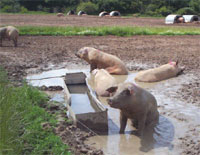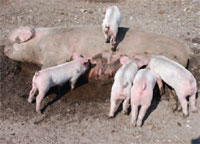



Meteorological Effects on Seasonal Infertility in Pigs
A study at Leeds University in the UK shows it is important for farmers to provide outdoor sows with methods to keep themselves comfortable throughout the year and, crucially, not only during the summer months. Painting outdoor huts white and insulation help to keep sows both comfortable and productive, while wallows and sprinklers need to be provided early in the year and throughout the summer months.This note highlights key findings from a BPEX-funded PhD studentship carried out by the University of Leeds. The aim of the research was to describe the effects of meteorological conditions on reproductive function in both outdoor sows and commercial boars and to establish whether seasonal infertility really exists.
The main causes and manifestations of seasonal infertility were explored along with the possibility of whether or not its occurrence can be anticipated and modelled.
A dataset of 122,391 farrowings from 32,935 sows in 29 similarly managed herds was used for analysis, for the years 2004 to 2009.
The results clearly showed that seasonal influences on the fertility of outdoor UK sows do exist. There was also evidence of seasonal changes in boar semen quality. The main impact of seasonality on production in sows was reduced farrowing rates. Temperature, meteorological conditions and photoperiod were the key factors identified as important through the research.
 |
 |
 |
Day-length
- Rapid changes in day-length, i.e. around the equinoxes, improved farrowing rates, regardless of whether they were lengthening or shortening
- This observation suggests that it is long days and not lengthening days which result in reduced fertility
- Long days normally coincide with warmer temperatures and longer exposure to higher temperatures, so in the UK. it can be said that changes in temperature are the main driver of seasonal infertility in outdoor sows.
Temperature
- Rises in temperature can have a pronounced effect on the reproductive ability of sows, especially following a period of cold
- In this research, a lower tolerance for increased temperatures in outdoor sows was found (18 to 20°C) compared to the literature available on sows kept indoors (22 to 25°C); this suggests adaptation to the cold
- Even if temperatures are considered mild at around 20°C, if sows have habituated to colder temperatures, this may be enough to cause them to react adversely.
Genetics
- It should be noted that individual sows may be more/less tolerant to these changes than others, with over 25 per cent of sows in the dataset never being affected by seasonal infertility, and that seasonal effects on litter size were less apparent when assessed at herd level
- This observation suggests a genetic predisposition to seasonal infertility and environmental stressors
- If genetic lines for the more tolerant individuals could be traced back it may be possible to significantly reduce seasonal infertility in the UK pig herd.
Boars
- Semen quality was reduced over the summer and early autumn months, with a higher proportion of abnormalities and lower sperm concentrations recorded
- However, individual boar and management parameters had a larger effect on semen quality than meteorological conditions
- Semen volume was found to be greatest in autumn and winter, when day length was shortening
- Four day collection intervals are optimal for low abnormality percentages, especially in summer
- Weather conditions were not found to influence semen volumes, reinforcing the importance of photoperiod as opposed to temperature for this trait
- Many farms have catcher boars whose semen is not checked prior to every insemination
- With sows failing to conceive more often in summer and, therefore, being served by the catcher boar, this may increase the chance of smaller litters and reduced farrowing rates.
Conclusions
Practical implications
- Farmers need to provide outdoor sows with methods to keep themselves comfortable throughout the year and, crucially, not only during the summer months
- Other studies have shown that painting huts white can reduce the temperature inside by up to around 7°C as sunlight is reflected off the surface
- Insulating huts will also help to reduce the internal temperature of huts
- Wallows and sprinklers provided early in the year and throughout summer will help sows to keep cool.
Recording and models
- Record keeping may need to be expanded so that more detailed and accurate records can be maintained; these could then be fed into a system for predicting performance, seasonal or otherwise
- Farmers need to see record keeping systems as a tool for optimising production
- The simulation model produced in this research showed that sow production can be anticipated in advance using previously recorded data
- Improved monitoring of sow reproductive output during periods of seasonal infertility and stricter culling rules for sows exhibiting increased problems may help eliminate some of the seasonal infertility observed on farms.
Genetics
- If freeze-thaw technology for boar semen was perfected, a change in the way semen is collected over the year may be possible, with higher throughput during winter in order to compensate for summer reductions in fertility
- Genetic research into seasonality may reveal sow lines which are more tolerant of changes in environmental conditions and therefore less likely to exhibit signs of seasonal infertility.
November 2013








